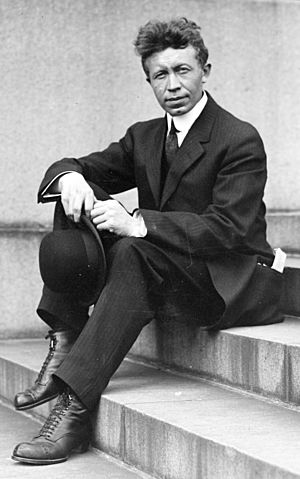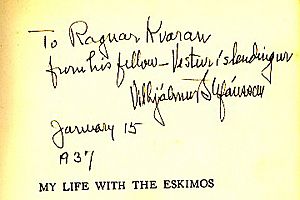Vilhjalmur Stefansson facts for kids
Quick facts for kids
Vilhjalmur Stefansson
|
|
|---|---|

Stefansson, circa 1915
|
|
| Born | November 3, 1879 Manitoba, Canada
|
| Died | August 26, 1962 (aged 82) |
| Alma mater | Harvard University University of Iowa University of North Dakota |
| Occupation | Harvard University Professor Arctic explorer |
| Organization | President of the History of Science Society from 1945–46 |
| Known for | Exploring the Arctic |
Vilhjalmur Stefansson (Icelandic: Vilhjálmur Stefánsson) was an Icelandic American Arctic explorer. He was also an ethnologist, someone who studies different cultures. Born on November 3, 1879, in Manitoba, Canada, he passed away on August 26, 1962, at 82 years old.
Contents
Early Life and Education
Stefansson was born William Stephenson in 1879 in Arnes, Manitoba, Canada. His parents had moved there from Iceland two years earlier. After facing tough times, including floods, his family moved to North Dakota in 1880.
He went to the University of North Dakota and the University of Iowa, earning a degree in 1903. In 1899, during his college years, he changed his name to Vilhjalmur Stefansson. He then studied anthropology (the study of human societies and cultures) at Harvard University, where he also taught for two years.
First Arctic Adventures
In 1904 and 1905, Stefansson worked on archaeological research in Iceland. He joined the Anglo-American Polar Expedition in 1906. During the winter of 1906–1907, he lived with the Inuit people in the Mackenzie Delta. He then traveled back alone across the land.
From 1908 to 1912, he and Dr. Rudolph Martin Anderson explored the Central Arctic coasts of North America. They were doing an ethnological survey for the American Museum of Natural History in New York City.
In 1908, Stefansson hired an Inuk guide named Natkusiak. Natkusiak became his main guide for all his future expeditions in Alaska. Stefansson met Natkusiak through Captain George Baker Leavitt Sr., a whaling ship captain who sometimes brought supplies to Stefansson.
Stefansson became interested in a group of Inuit people he called "Copper Inuit." He heard about them from [[Christian Klengenberg in 1910. These Inuit were known for having lighter hair. Newspapers later called them "Blonde Eskimos," a term that became very popular.
The Karluk Disaster
Stefansson led the Canadian Arctic Expedition, 1913–1916 for the Canadian government. The goal was to explore areas west of the Queen Elizabeth Islands. Three ships were used: the Karluk, the Mary Sachs, and the Alaska.
In August 1913, the main ship, the Karluk, got stuck in the ice. Stefansson and five others left the ship to hunt for food. However, some people left on the ship believed Stefansson left on purpose. They thought he expected the ship to drift away with the ice, which it did.
The Karluk, with Captain Robert Bartlett and 24 others, drifted westward. It was crushed by the ice and sank on January 11, 1914. Many survivors tried to reach land, but sadly, several died from the harsh conditions. Captain Bartlett and his Inuk hunter, Kataktovik, traveled across the sea ice to Siberia to get help. The remaining survivors were eventually rescued by two ships.
Stefansson continued his explorations by sledge over the Arctic Ocean (also known as the Beaufort Sea). He left Collinson Point, Alaska, in April 1914. He and two men traveled for 96 days, mostly living by hunting polar game. Stefansson continued exploring until 1918.
The Wrangel Island Problem
In 1921, Stefansson encouraged an expedition to Wrangel Island, north of Siberia. He wanted four young men to colonize the island. This was the same island where survivors of the Karluk had lived in 1914. Stefansson hoped to start a company for Arctic tours.
Stefansson first wanted Canada to claim Wrangel Island. But the Canadian government refused to help because of the dangers of his earlier trip. He then tried to get Britain to claim it. However, the British government also said no. Raising the British flag on Wrangel Island, which was Russian territory, caused an international problem.
The four young men Stefansson recruited were not experienced enough for the trip. They were Americans Frederick Maurer, E. Lorne Knight, and Milton Galle, and Canadian Allan Crawford. All of them died on the island or trying to get help. The only survivor was Ada Blackjack, an Inuk woman hired as a seamstress and cook, and the expedition's cat, Vic. Ada learned survival skills and cared for the last man, E. Lorne Knight, until he died. Ada was rescued in 1923, after spending two years on Wrangel Island.
Stefansson faced a lot of public anger for sending these young explorers to Wrangel Island. This disaster, along with the Karluk sinking, greatly damaged his reputation.
Amazing Discoveries
Stefansson made many important discoveries during his expeditions. He found new land, including Brock, Mackenzie King, Borden, Meighen, and Lougheed Islands. He also mapped the edge of the continental shelf. His journeys and successes are considered incredible achievements in Arctic exploration. He continued the work of earlier explorers like Francis Leopold McClintock. From April 1914 to June 1915, he even lived on the ice pack.
In 1920, it was reported that Stefansson found a lost supply cache from the 1853 McClintock expedition on Melville Island. The clothing and food were in excellent condition despite the harsh Arctic weather.
In 1921, he received the Founder's Gold Medal from the Royal Geographical Society for his Arctic explorations.
Later Career and Legacy
Stefansson remained a famous explorer throughout his life. Later, he worked with Dartmouth College as the Director of Polar Studies. He played a big part in creating the US Army's Cold Regions Research and Engineering Laboratory (CRREL) in Hanover, New Hampshire. This lab helped develop equipment and methods for fighting in cold, mountainous areas.
Stefansson joined the Explorers Club in 1908 and served as its President twice. He supported women in exploration and anthropology. In 1938, the Club created a "Woman's Roll of Honor" to recognize women's achievements in exploration. He also mentored Gitel Steed, who researched diet and how people get food for his book Lives of the Hunters.
In 1940, he met Evelyn Schwartz, who became his secretary and later his wife. He was named an honorary member of the American Polar Society in 1941. He also served as president of the History of Science Society from 1945–46.
Stefansson's personal papers and Arctic artifacts are kept at the Dartmouth College Library. They are available for the public to study.
He is often quoted saying, "An adventure is a sign of incompetence..." meaning that good planning prevents unexpected problems. The famous explorer Roald Amundsen once called him "the greatest humbug alive," possibly because Stefansson believed the Arctic environment was more "friendly" than it actually was.
On May 28, 1986, the United States Postal Service issued a 22-cent postage stamp in his honor.
Political Involvement
In the 1930s, Stefansson supported a group called the American Committee for the Settlement of Jews in Birobidjan (Ambijan). This group aimed to help Jewish people settle in a special region in the far east of the Soviet Union. Stefansson spoke at many Ambijan meetings and was a member of their Board of Directors. He believed this project was a great way to help Jewish people from Eastern and Central Europe.
In 1944, Stefansson and his wife, Evelyn, hosted a public dinner for Ambijan's national conference. He was chosen as one of the organization's vice-presidents.
However, after World War II, some people in the US became very against the Soviet Union. In 1951, Stefansson was accused of being a communist. In his autobiography, published after his death, he did not mention his work with Ambijan. His obituary in The New York Times also did not mention it.
Literature
- Stefansson, Vilhjalmur. My Life with the Eskimo; The Macmillan Company, New York, 1912.
- Stefansson, Vilhjalmur. The Friendly Arctic; The Macmillan Company, New York, 1921.
- Stefansson, Vilhjalmur. Unsolved Mysteries of the Arctic; The Macmillan Company, New York, 1938.
- Stefansson, Vilhjalmur. Discovery – the autobiography of Vilhjalmur Stefansson; McGraw-Hill Book Company, New York, 1964.
- Niven, Jennifer. The Ice Master: The Doomed 1913 Voyage of the Karluk, Hyperion Books, 2000.
- Niven, Jennifer. Ada Blackjack: A True Story Of Survival In The Arctic, Hyperion Books, 2003.
See also
 In Spanish: Vilhjalmur Stefansson para niños
In Spanish: Vilhjalmur Stefansson para niños


